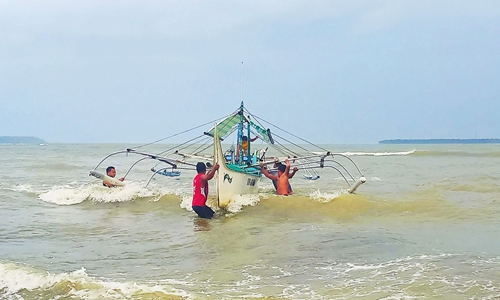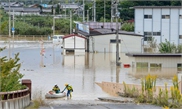Tropical storm follows Haiyan’s path
Filipino authorities urge coastal evacuations amid Phanfone’s landfall

Residents help carry a wooden fishing boat into a secured area along the coast in Borongan town, Eastern Samar province, central Philippines, on Monday, as they prepare for Typhoon Kammuri, which churned closer, forcing evacuations and threatening plans for the Southeast Asian Games events near the capital, Manila. Photo: VCG
Thousands of people in typhoon-prone central Philippines have had their Christmas plans ruined after they were told to leave their homes as a severe tropical storm approaches.Officials on Christmas Eve said residents should evacuate coastal areas, and thousands more were stranded at ports with ferry services shut down as the nation hunkered down for rain and strong winds.
Damaging gale- to storm-force winds were forecast over the Asian nation's Pacific coast in the afternoon ahead of Tropical Storm Phanfone's projected landfall on Samar island as early as 5:00 pm (0900 GMT), the state weather service said.
Though much weaker, Phanfone was tracking a similar path as Super Typhoon Haiyan, the country's deadliest cyclone on record which left more than 7,300 people dead or missing in 2013.
All ships on the storm's projected path through the central islands were ordered to stay in port, while executives there told residents of the coasts as well as flood- and landslide-prone areas to move to safety.
"Some families are reluctant to evacuate because they want to celebrate Christmas at home, but officials will force them out if they refuse to heed our warnings," regional civil defense official Reyden Cabrigas told AFP.
More than 21,000 ferry passengers trying to get home for the mainly Catholic nation's Christmas holidays have been stranded at ports as shipping shut down, the coast guard said Tuesday.
The state weather service said Phanfone, Laotian for "animal," may strengthen into a typhoon with sustained peak winds of more than 120 kilometers an hour overnight Wednesday.
It advised residents, including those in Manila, to stay indoors on Christmas Day to avoid the high winds which can cause damage to weaker structures.
The Philippines is the first major landmass facing the Pacific cyclone belt, and the archipelago gets hit by an average of 20 storms and typhoons each year, putting millions of people in disaster-prone areas in a state of constant poverty.
Strong winds and associated dangers like floods, landslides, and, more rarely, giant walls of seawater pounding the coasts kill scores of people each year, wipe out farmers' harvests and destroy infrastructure.
Homes built with flimsy materials, as well as populated areas along the coasts, floodplains, and mountainous interiors, are often the most vulnerable.
AFP

